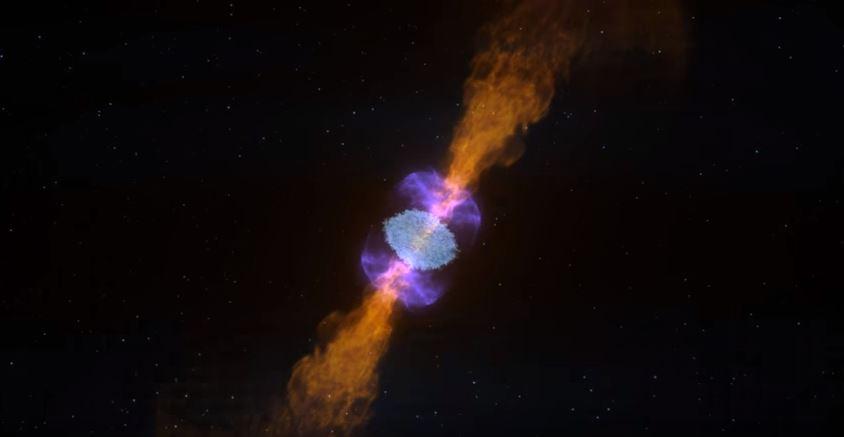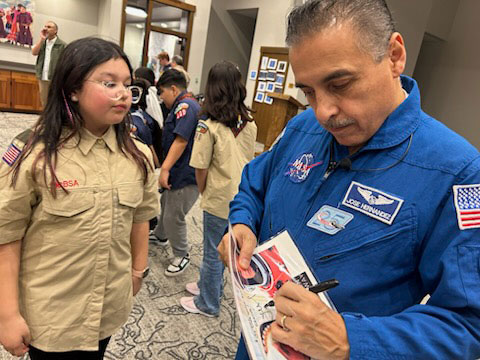
At Hanford, Watching Neutron Stars Collide: Just Another Day (And 130 Million Light Years) At Work
Listen
The scientific community is on fire this week. And a physics research lab in Washington is partly to credit. For the first time, scientists observed a cosmic event involving gravitational and electromagnetic waves.
You may have heard about it by now: two neutron stars collided. And not only did astronomers receive alerts as the collision occurred, but they were able to catch the show in full light and sound.
Dr. David Reitze, executive director of the LIGO Laboratory at Caltech, explains with an analogy.
“This is the first time the cosmos has provided what I would call a talking movie,” Reitze says. “We moved from the era of silent movies to talking movies. In this case, the audio soundtrack comes from the chirp of the neutron stars as they are inspiraling, as they are orbiting together and colliding and the video is basically the light we are seeing after the collision.”
The “Chirp”
The “chirp” Reitze is talking about was recorded at Washington’s LIGO Hanford laboratory near Richland. LIGO stands for Laser Interferometer Gravitational Wave Observatory. You may have heard about them because scientists from LIGO Hanford were part of the team that recently won a Nobel Prize in Physics for their previous work on gravitational waves and black holes.
While most observatories are meant to scan the cosmos for electromagnetic waves like gamma rays or visible light, LIGO is meant to “hear” the cosmos through gravitational waves. These waves are also called “ripples in space-time.” They’re part of Albert Einstein’s general theory of relativity. (Here’s a quick breakdown for more context.)
What does all this mean? While both gravitational and electromagnetic waves have been measured before, they have never been recorded for the same event, at the same time.
In mid-August, physicists from LIGO Hanford, LIGO Livingston in Louisiana, and the Italian-based Virgo Detector all registered a gravitational wave, or “chirp.”
While LIGO has received chirps like this before, they usually came from black holes and lasted mere fractions of a second. But this time the chirp was the result of a ripple in space-time signaling the collision of two neutron stars.
And the chirp lasted 100 seconds.
Correction: Oct. 18, 2017: This story has been updated to remove a reference to black holes not having mass. Indeed, they do. (Though we’re pretty sure they don’t have “Mass” since Transubstantiation is hard to do in black holes for a litany of reasons.) See more on black holes and mass from NASA.
Neutron Stars FYI
Neutrons are the smallest, densest stars in the universe. A single teaspoon of a neutron star is as heavy as Mount Everest. The collision created gamma ray bursts, a powerful kind of electromagnetic radiation, and then went through the full electromagnetic spectrum. That means radio waves, microwaves, infrared, visible light, UV light, and x-rays.
In other words, a show in full color.
Seventy ground and space-based telescopes and observatories around the world witnessed the neutron stars collide.
While the actual collision took place 130 million years ago, scientists are only seeing it now because of the finite speed of light. Since the neutron stars were also 130 million light-years from Earth, a long delay occurred as the light from the event traveled to us.
So when we observe stars and other celestial bodies, we aren’t looking at what objects look like now, but what they looked like a long time ago.
Michael Landry is the head physicist at LIGO Hanford. He’s ecstatic because the event proved something physicists long thought: Heavy metals like gold and lead were produced during events called kilonovas.
“So if you look at your ring or your necklace, the gold in that piece of jewelry came to be through collisions of neutron stars back billions of years ago,” Landry says.
Here on Earth, those materials are mined and sometimes highly prized. But whether it’s a precious metal used in electronics or a platinum wedding ring, half of the elements heavier than iron are from the cosmos, crafted in the bellies of stars. And for the first time, scientists witnessed to witness the event that created them.
As for the remains of the collision, that’s one burning questions. Michael Landry from LIGO Hanford believes the collision could have created a newly formed black hole, but no one is sure yet.
In the next few months, more research from this phenomenon will arise as scientists publish their findings.
(Special thanks to Curtis McCully of the Las Crumbres Observatory Global Telescope Network and University of California Santa Barbara for help in fact checking and understanding some of the more complicated scientific aspects of this story.)
Related Stories:

Head Start serves 15,000 kids in Washington. And its regional office just closed.
The regional Head Start office closed this week, making some advocates nervous about the program’s future. (Credit: Barnaby Wasson / Flickr Creative Commons) Listen (Runtime 1:00) Read The regional Head

Astronauta de la NASA José Hernández inspira a estudiantes durante visita a Tri-Cities
EL astronauta de la NASA José Hernández visitó el este de Washington y compartió su historia de resiliencia y determinación con estudiantes locales.

Washington, Idaho rank high for public health emergency preparedness
Both states saw steady or increased funding for public health, but Idaho still among lowest for vaccinations.













